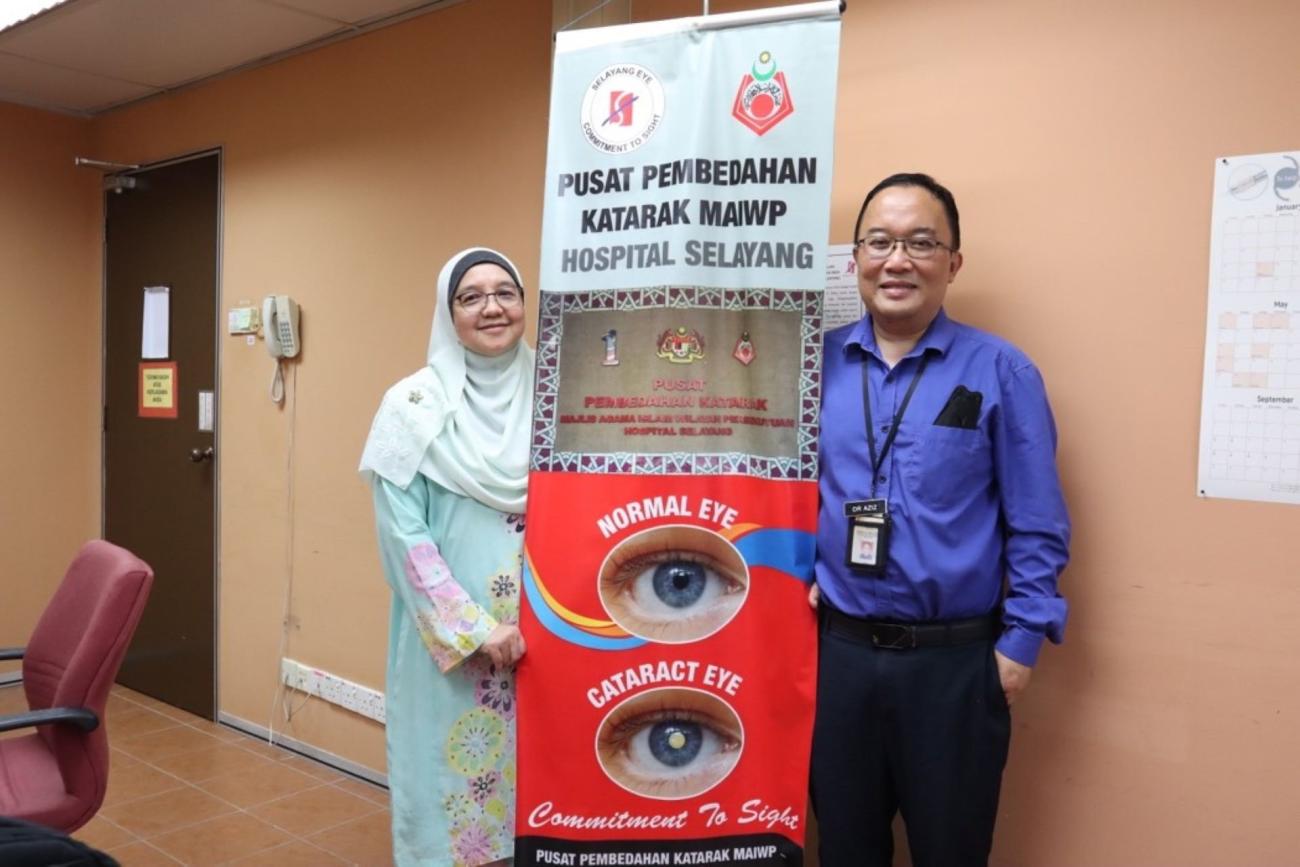Innovative approaches to reduce cataract-induced blindness and vision impairment in Malaysia

Cataracts present a major global health challenge as the leading cause of vision impairment and reversible blindness.
“Previously, the world felt dark when I was not able to see. I am so grateful and happy now – I look forward to the next surgery for my other eye,” said Nuriha binti Badoot @ Kusni, a patient at the Pusat Pembedahan Katarak Majlis Agama Islam Wilayah Persekutuan-Hospital Selayang.
Cataracts present a major global health challenge as the leading cause of vision impairment and reversible blindness. Untreated cataracts add significantly to this burden. The 2014 Malaysian National Eye Survey underscored the high prevalence of visual impairment and blindness, mainly due to untreated cataracts among Malaysians aged 50 and above. Remote communities experienced an even greater burden of cataract-related vision problems, worsened by long waiting times for surgery.
Since 2010, the Ministry of Health Malaysia (MOH) has actively sought innovative approaches to expand cataract surgical care access to underserved communities. This vision materialized in 2012, with the establishment of the Pusat Pembedahan Katarak Majlis Agama Islam Wilayah Persekutuan-Hospital Selayang (PPKM-HS), a specialist centre led by a group of national ophthalmologists and optometrists and supported by the Federal Territory Islamic Religious Council. PPKM-HS transformed a four-story shop near Selayang Hospital into a premier cataract surgery centre, operating as a hub of excellence.
PPKM-HS implemented several innovative approaches. An efficient specialist rotation system was introduced, which enabled the small in-house team to coordinate visiting ophthalmologists and medical officers from 8 tertiary hospitals. A set of standardized procedures, such as optical biometry and lens selection, was developed to guarantee high-quality outcomes. Finally, a patient-centred approach was adopted, offering patients one-week decision periods and fostering mental preparedness, effectively reducing surgical complications and enhancing patient satisfaction.
Since its inception, PPKM-HS has reduced the waiting time for a cataract surgery to just two weeks, a six-fold improvement compared to the 16-week average at MOH tertiary hospitals. Furthermore, the centre achieved lower complication rates compared to other hospitals.
At the same time, a specialized service model designed for rural areas, known as the mobile cataract clinic, was introduced by the same group of national ophthalmologists and optometrists in 2013 in Sarawak. This initiative transformed the previously informal cataract camps into a well-organized and systematic approach to cataract surgery. In the early 1990s, cataract surgery camps used the extracapsular extraction (ECCE) method without regularly collecting data on surgical performance or patient outcomes. However, the mobile clinic shifted to the phacoemulsification (PE) surgical method and implemented a structured data collection process to monitor surgical performance and patient outcomes. This approach gained support from local ophthalmologists and built trust among patients.
These mobile clinics operate on weekends outside of regular office hours, bridging the accessibility gap for rural residents. The three-level coordination, involving the MOH management team, state hospital coordinating team, and district hospital supporting team, ensures the effective execution of each visit. In Sarawak alone, this initiative has significantly enhanced accessibility, affordability, and reduced waiting times for cataract care in 7 district hospitals situated 50 to 300 kilometres away from the state hospital. This has been particularly beneficial for residents in remote villages who might otherwise have to forego cataract surgery.

Between 2013 and 2019, Sarawak's mobile clinics screened 22 000 patients and performed 4155 surgeries for free, achieving better outcomes and higher follow-up rates than tertiary hospitals. In 2016, the Ministry of Health Malaysia launched the Klinik Katarak-Kementerian Kesihatan Malaysia (KK-KKM), incorporating the one-stop cataract service center as KK-KKM Static and the mobile cataract clinic as KK-KKM Mobile. This effort catalyzed the expansion of decentralized cataract surgery services and new service delivery models in other states. The initiative received recognition and awards for its positive impact on patients' lives: PPKM-HS received the Prime Minister’s Innovation Award in 2014, and KK-KKM Mobile was acknowledged as the highest impact program in MOH by the Health Service Transformation Plan of the Public Service Departmentin 2017.
Challenges persist, including specialist shortages, limited local ownership, and insufficient funding, hindering the scalability and impact of these innovative approaches. As stated by Dr Mohamad Aziz Salowi, Public Health Ophthalmologist and Country Coordinator for KK-KKM: “For such a program to move, we cannot move alone. This is what I have learned over the years. We need support from everyone - we need support from policy and instruction from above. We need to collaborate with others, not only NGOs, but also within the divisions of the Ministry of Health, and to coordinate outside the Ministry of Health.”



